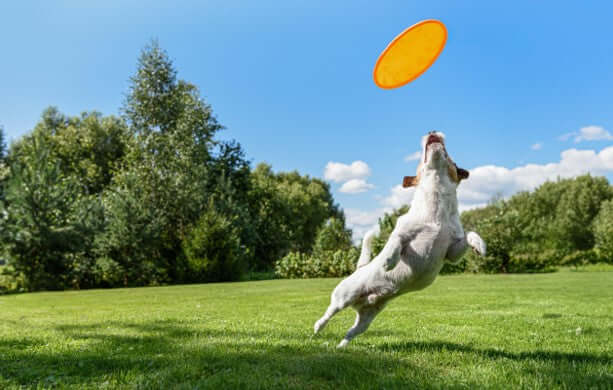As Great Outdoors Month ushers in, there's no better time to explore and enjoy water activities, especially with your canine companion. While swimming is a fantastic exercise and a fun way to stay cool, it's crucial to ensure your dog's safety and enjoyment. Here's an expanded guide on the top 10 things to consider for a safe and joyful swimming experience with your dog.
1. Evaluating Swimming Skills
Not all dogs take to water like ducks. Breeds with heavy chests and short legs may find swimming challenging. Before heading to a deep pool or lake, start with shallow waters. Observe if your dog paddles with both front and back legs; some dogs only use their front legs, tiring out more quickly. Introducing your dog to water at a young age can help, but older dogs can also learn to enjoy swimming with patience and encouragement. A life jacket is advisable for extra safety, especially for breeds that are not natural swimmers.
2. Choosing a Safe Location

Finding a suitable location is paramount. Avoid areas with strong currents or riptides, and always opt for clean, calm, or gently flowing waters. Research dog-friendly spots ahead of time. Public pools may have specific dog swim days, and some beaches are more welcoming to dogs than others. Look out for signs warning of pollutants or blue-green algae, which can be fatal to dogs if ingested. Your ideal spot will have clear water, a gentle slope, and enough space for your dog to play and rest.
3. Protection Against Parasites and Diseases
Waterborne pathogens can pose a significant health risk to your dog. Before your swimming adventure, ensure your dog is up-to-date on all vaccinations and has protection against fleas, ticks, and heartworm. Parasites like giardia can be ingested through contaminated water, leading to gastrointestinal distress. After swimming, thoroughly rinse your dog with fresh water to ensure they are fresh and clean.
4. Ensuring Proper Hydration and Overheating Prevention

It's a common misconception that dogs will not get dehydrated because they are in water. Dogs can get so focused on playing that they forget to drink, or they may ingest salty seawater, which actually increases dehydration. Always bring fresh, clean water and a portable bowl, encouraging your dog to drink every 30 minutes. Be vigilant for signs of overheating, such as excessive panting, drooling, or lethargy, and know that dogs can also suffer from heat stroke in water if they're overexerting themselves under the hot sun.
5. Utilizing a Dog Life Jacket
A life jacket is not just for safety; it also gives dogs more confidence in the water. Choose a brightly colored life jacket with reflective strips for visibility. The handle on the back is crucial for lifting your dog out of the water if they're in distress or tired. This is particularly important for open water swimming where currents can change quickly, and safe exits may not always be nearby.
6. Constant Supervision
Always keep a close eye on your dog when they are in or near water. It's essential to stay within reach, ready to assist if your dog struggles. Ensure your dog knows how to get out of the pool or find the shore from their swimming spot. Practicing entering and exiting the water can help prevent panic in an unexpected situation.
7. Respecting Wildlife and Environment

When swimming in natural bodies of water, it's crucial to be aware of the local wildlife. Teach your dog to avoid contact with marine animals and to stay away from fishing lines or other potential hazards. Be mindful of the impact your dog may have on local fauna and flora. Stick to designated swimming areas to minimize ecological disruption and ensure the safety of your pet and the environment.
8. Reinforcing Recall Commands
Before allowing your dog to roam off-leash, make sure they respond reliably to recall commands. This is vital for their safety, especially near water, where distractions abound. Training with positive reinforcement can improve their response to commands, even in exciting or distracting environments. This practice ensures you can quickly call them back to safety if necessary.
9. Caring for Your Dog's Ears

Dogs with floppy ears are prone to ear infections, which can be exacerbated by moisture. Consider using ear protection designed for dogs, and always dry their ears thoroughly after swimming. If your dog is prone to ear infections, consult your vet for preventive measures or treatments to ensure swimming doesn't lead to uncomfortable conditions.
10. Acclimation and Enjoyment

For many dogs, swimming is an acquired taste. Introduce your dog to water gradually, using positive reinforcement and patience. Toys and treats can motivate them to enter and enjoy the water, but never force a reluctant dog to swim. Each dog's pace will differ, and it's crucial to turn the experience into a positive one. Over time, your dog may grow to love the water as much as you do.
Conclusion
Swimming with your dog can be an enriching activity, offering both physical exercise and mental stimulation. By preparing properly and keeping these ten essential tips in mind, you can ensure a safe and enjoyable experience. Remember, each dog has its own personality and preferences, so adapt your approach to fit your furry friend's needs. Here's to a splashing good time during Great Outdoors Month and beyond!
More stories

Buzz Worthy News: May 20th is World Bee Day!


